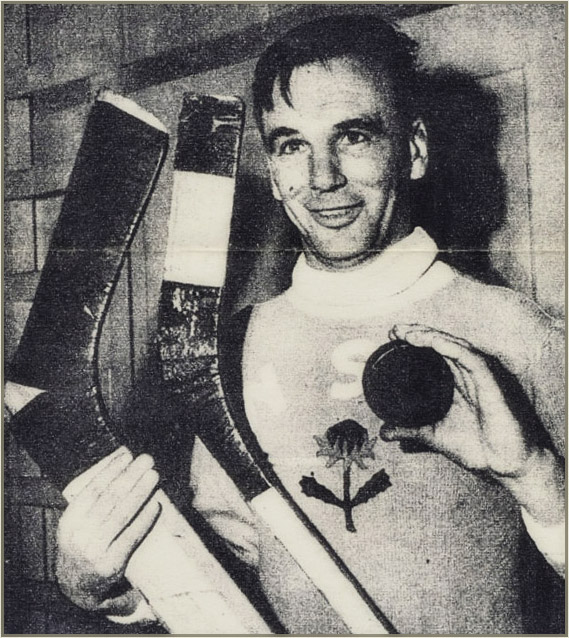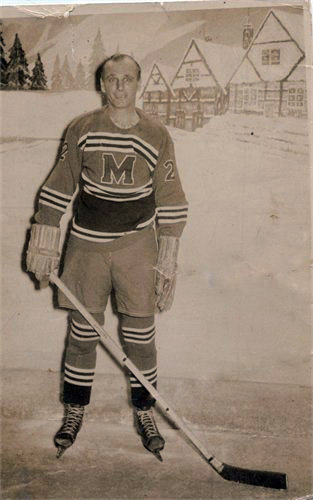

[Top] Percy Wendt in State colours, a favourite with Sydney fans. He was never booed and he appreciated the fact. Image courtesy Sporting Life magazine, 1953 [5] [Beneath] Sydney Glaciarium, undated.
CAREER SUMMARY
Birth
24 Dec 1912
Moscow Russia
Death
16 Nov 1995
Ballina NSW Australia
Clubs
NSWIHA Easts, NSWIHA St George
Goodall Cups
1931, '32 (tie), '33, '34, '35, '38, '46 (tie), '48, '50 (9)
Life Memberships
Nil
Captain of NSW
Coach of Easts
Top point scorer of first half century of Australian hockey
BORN PERCY FREDERICK OTTO WENDT on Christmas Eve 1912 in Moscow Russia, to parents Fritz (Frederick) Johannis Carl Wendt and Julia Roots, [5] who married at York in Toronto, Ontario, Canada on December 22nd 1911. His English-born father was an accountant for multi-national expansions, living a year or two at a time in England, Russia, South Africa and Canada. [5] Wendt spent the formative development years of his hockey career in the village of Parkdale in Toronto, from around the time the Sunnyside Amusement Park and Palais Royale opened nearby. Parkdale back then was one of Toronto's most desirable places to live, situated as it was by the lake, nearby the Canadian National Exhibition, and Sunnyside Beach.
Young Percy celebrated his 16th birthday at sea on MMV Aorangi. He arrived in Australia with his family from Vancouver BC on January 4th 1929 and they lived in the terrace house at No 10 Craigend Street in Darlinghurst. [5] It was immediately east of Sydney's Central Business District, from where Fritz continued to account. Percy swam at Tamarama Beach, played cricket at Rushcutter's Bay, and golf at Moore Park.
Pop Kennedy steered the thin-faced, tall and lanky youngster who sauntered into the Glaciarium, directly into Easts' dressing-room. Pop was the father of Ken, the Olympic speed skater and hockey player. He was trapped protesting in an Easts jersey and pads, with a stick thrust in his hand, no less than six seasons out from Easts' last premiership. A few fans laughed when Wendt skated out a short time later in his queer, shuffling style with the Easts reserves. But not Pop. Partnered with Ken Kennedy and Pat Jackson, Wendt made the St George Reserves look ordinary and just grinned when told he still had the late game to go against Jimmy Brown's Dragons. "Well, I'm easy" he told Pop, "but I haven't played for two years."
Wendt played all over the Dragons' forwards, scoring the goal that forced a one-all draw. He didn't go out to hit, he wasn't built for it, preferring instead to carefully ration his energy. The skating may have looked a bit weird, but his steady shuffling technique was well-suited to the high hockey IQ that was sending the instructions to his legs. St George won the premiership that year, but Wendt had made his mark.
Later that season he represented New South Wales against Victoria for the first time, scoring goals, and winning the State's twelfth Goodall Cup. The next season his club, Easts, were state champions winning their third Hamilton Trophy. A fourth followed in 1934, but Brown's fully renovated and extended Dragon-killers eventually found a way round Pop, and he joined St George in 1935. In the final, Brown played out of position to boost the forward line, but Wendt was the star. [2] It was both his and the club's third premiership. According to the local press, his shots were full of power and accurate, and his stickwork once again brilliant. [2] The 1935 premiership turned out to be just the first of three for St George, from four attempts — 1935 to 1938.
A local paper reported "Went ... does not shirk the rough and tumble when it comes to a point, but he prefers to dazzle the opposition with science in a remote and unconnected sort of way, leaving in his wake a puzzled lot of players who feel so completely thwarted that they would like to whack him hard with their sticks. Went has that summation of skills that marks the ice hockey genius. He can handle the puck with his stick as effectively as most fans can handle their knives and forks, and he swerves like nothing so much as an errant possum, in and out, round and about, and always with some fell purpose hidden way back in his brain-box, which, when revealed, makes you gasp at his subtlety".
New South Wales forward, Jim Wiseman, once recalled a strange coincidence in the 1938 State team where all its members — Percy Wendt, Jimmy McLachlain, Bill Frazer, Frank Harvey and Jimmy Brown — were employed at one Sydney firm. [3] That was also the year Wendt played the visiting Canadian Bears in the NSW All-Stars team with Widdy Johnson, Moller and Ridgeway. He was also left wing to the Chicago Blackhawks one-gamer, Tom Coulter, in the memorable St George match against the visitors on September 14th. "Nobody in Canada will believe the good opposition you have given us," said the visiting Bears manager, Ken Lewis. "We are supposed to be invincible in hockey. Of course, you must admit that the old guy from Toronto Canada, who played for New South Wales had a big part in your smart moves... Percy Wendt, or as we know, Lefty Wendt." [1] Wendt was only 26 and that "Lefty" nickname stuck. His former countrymen had watched him play left-handed ice hockey, golf, cricket, baseball and tennis. They were impressed.
"Percy Wendt, who came in for some eulogies in The Referee a fortnight ago, earned them all over again," wrote Left Defense in June 1937. [7] "But he went even further, this wizard of the swerving skates, for his shooting at goal was so good that even the die-hards who have been watching the game for as many years as Wendt has lived, openly averred that his shooting came up level to that of the great Jimmy Kendall, who remains in their minds as the Don Bradman of Australian ice-hockey. Wendt, with a flick of the stick that reminds one forcibly of the famous Indian field hockey players, was able to shoot the puck from any angle or distance. Two of his shots on Thursday, from half-way, went zooming high over the goal, phenomenal examples of strength of wrist and precision of timing. Mr J Kennedy, well-known Ice-hockey official, commented that Wendt is to ice-hockey what a master of the rapier is to fencing".
Wendt decided to go with his friend and fellow Canadian ex-pat, Jimmy Bendrodt, and a few others when they departed the NSW association to form their own. The dispute became plain nasty leaving him out of the sport for a season and probably also the war years. The management committee of the local association announced player suspensions from 2 to 5 years duration. Wendt and Widdy Johnston were suspended for three years. The former state goalie, Norm Macmillan, got five. Many others suffered lesser terms, but all in years. [3] The committee did not issue any reasons for the suspensions.
Wendt was a 23 year-old carter when he married Eileen Coady in August 1936 at the Burton Street Tabernacle near where Bendrodt lived. The couple moved further out to 20 Ashley Street and later 362 Birrell Street in Tamarama, a small ocean beach about 1 km south of Bondi Beach, where they raised two children, Stephen and Sandra. The Wendt's former church is now home to the Darlinghurst Theatre Company. Percy enlisted in the Army in November 1939 and served six years as a sapper in the Middle East and New Guinea with the 6th Division Signals until his discharge in October 1945 from 2/33 Australian Infantry.
When the bitter acrimony of the breakaway administration abated, Wendt and the others were reinstated by the association. He rejoined his original club, Easts, and also began to coach the team. He set-up a coaching school at the St Moritz rink in Melbourne at the invitation of the Victorian association. He succeeded Jimmy Brown as captain of New South Wales for three seasons — 1947, 1948 and 1949. By 1951, he was the last man standing from the 1931 team in which he had first competed 20 years earlier, still playing against visiting Canadian and European teams. In 1952, at the age of 40, an old knee injury forced him off the ice for a period, and he missed state selection.
Percy Wendt won 7 Goodall Cups and tied 2 representing New South Wales in most clashes with Victoria in the two decades between 1931 and 1951. He retired in 1953, a true 2-way forward who played left-wing, but who also looked great at centre-ice or in defense. He had the "demeaner of a bank teller and a feeling for the fellow taking the bumps". Those who had seen him play thought he was more successful in defense than offense, and that was saying something. Because the 23 goals he scored in Goodall Cup hockey between the wars, was second only to Jack Pike on 29. [6] Pike had been fed by Kendall and Leslie Reid, two of the all-time best quarterbacks in the local game. Some of the 4 goals scored by unidentified players during Wendt's Goodall Cup years may have been his, but it matters little. Percy Wendt surpassed Jack Pike's record during the interstate games he played after the war, to become the most successful goal scorer in the first half-century of the Goodall Cup.
Ross Carpenter, 'WENDT, Percy (1912 - 1995)', Legends of Australian Ice, Melbourne, Australia, http://icelegendsaustralia.com/legends_2/bio-wendt.html, accessed online .
Lefty: Percy Wendt and the game-changer goals, Ross Carpenter, Online
[1] Sporting Life, 1953, p 2. "Percy Wendt Just Keeps on Going"
[2] Referee, Sydney, 22 Aug 1935, p 2. St George Wins Premiership
[3] The Gosford Times and Wyong District Advocate NSW, 18 July 1952 p9
[4] Sydney Morning Herald 21 August 1939 p 15, Five Suspensions
[5] Wendt Family History Collection, Sandra Wendt, courtesy of Birger Nordmark
[6] Statistics assembled by Birger Nordmark, Sweden
[7] Referee, Sydney, by sports journalist "Left Defense", June 10th 1937.
| 1 - 280 | 281-on |

State Captain
Caption: About to shoot to score one of NSW's nine goals against Victoria's four in last night's ice hockey match at the Glaciarium. Victorian goalkeeper Noel McLoughlin, seen defending, was hit in the mouth by the puck, knocking out a couple of teeth. Truth, Sydney, NSW, 29 August 1948 p 18
